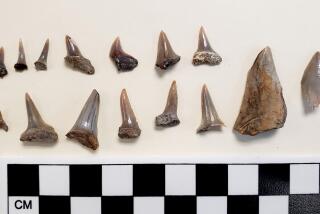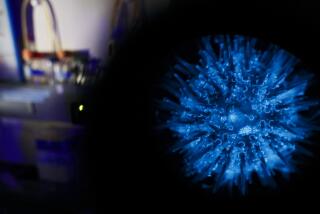Floating Lab a School for a Day : Children Study Wonders of the Deep Firsthand
- Share via
Ten-year-old Ben Lakin had just proclaimed how “rad” the baby octopus he was holding looked when the creature clamped 4-inch tentacles around his fingers and refused to budge.
“Oh God, he’s stuck,” Ben, eyes bulging with concern, groaned as he struggled with his free hand to extricate his fingers from the octopus’s surprisingly strong grip.
A supervisor helped the Capistrano Beach boy pry the octopus free and toss it back in a saltwater holding tank along with other specimens from the deep which had been caught Friday about a mile off Dana Point.
About 20 youngsters had sailed Friday on the maiden voyage of a floating deep-sea laboratory, on loan to Orange County Marine Institute from the University of Southern California.
The institute has operated a floating sea lab for nearly 20 years out of Dana Point Harbor, but always on a borrowed sportfishing boat. This year, for the first time, the institute is using a genuine research vessel, USC’s 65-foot Sea Watch.
Well-Equipped
The Sea Watch is a wood-hull sportfishing vessel modified for ocean research, complete with an onboard laboratory. With its intricate network of pulleys, cinches, buckets and nets, the Sea Watch is capable of hauling in roughly twice as many marine specimens as the old floating lab, said Tom Moylan, lab director.
And, with its much longer lines, the Sea Watch can extract specimens from thousands of feet. The old lab’s lines only went down about 150 feet, Moylan said.
And while it can accommodate up to 16 scientists for as long as six days, it will be used this summer for three-hour exploration cruises by the institute, an educational organization.
The cruises are offered to students who enroll in one-day marine study classes. Cost is $18 for adults and $9 for children under age 12.
On Friday, the Sea Watch made three trips to sea with groups of children from the San Clemente State Junior Lifeguards program. As the first cruise sailed out at mid-morning under clear blue skies, the 9- and 10-year-olds clustered around the bow to ooh and ah at each dip of the boat into large ocean swells.
“My stomach is somewhere else,” one girl muttered as the vessel sliced through blue-green waters past a buoy inhabited by sea lions and toward its first exploration point a half mile off the coast.
Don Kuhn, a junior lifeguard instructor, said the children had been looking forward to this.
“It’s like a real-life version of Jacques Costeau for them,” he said.
One of the more startling revelations came when the crew of scientists hauled up a net filled with plankton. Although the net looked almost empty, a look under the microscope at drops of water it shed revealed hundreds of squiggly creatures.
“You know when you get in the water and you feel all sticky?” Javier Gago, one of three marine institute instructors aboard, asked the junior lifeguards. “Well, it’s not saltwater which is sticking to you, it’s all these little animals.”
Specimens for Study
The Sea Watch extracted specimens from both shallow and deep water to show students the contrast. In about 50 feet of water, a chain-mesh net retrieved a clump of kelp and seaweed. Plant life is not as plentiful in deeper water because sunlight cannot reach it there, instructors explained.
Traveling to deeper water a mile from shore, the scientists lowered a bucket about 150 feet to retrieve a sample of sediment from the ocean bottom. When the bucket resurfaced, the scientists handed out samples of the clay-like sediment, in which students discovered worms and snails.
By now, it was time for the cruise’s prime attraction: the lowering of a large fishing net to scoop up the fish which inhabit the ocean bottom. Moments later, crewmen hauled the net back up and dumped into a holding tub several species of fish, as the children watched open-mouthed.
The children gathered close as Moylan held up what appeared to be a menacing stingray. It was, in fact, a harmless California skate. Then he pulled out an octopus, which immediately began wrapping its tentacles around his hand. When he placed it back in the tub, it sprayed protective red ink to hide itself in the red cloud.
Matt Pohlson, 10, of Laguna Niguel, liked the skate best of all.
“I love this,” he said with a smile, as he stroked the creature’s back. “It’s sort of slimy slick. It feels good.”
For 10-year-old Jimmy Farley of San Clemente, the real attraction awaited him on shore. He and the other students were scheduled to spend another two hours inside the marine institute dissecting fish.
“I like that part the best, because you get to see what they look like on the inside,” Jimmy said.
More to Read
Sign up for Essential California
The most important California stories and recommendations in your inbox every morning.
You may occasionally receive promotional content from the Los Angeles Times.










